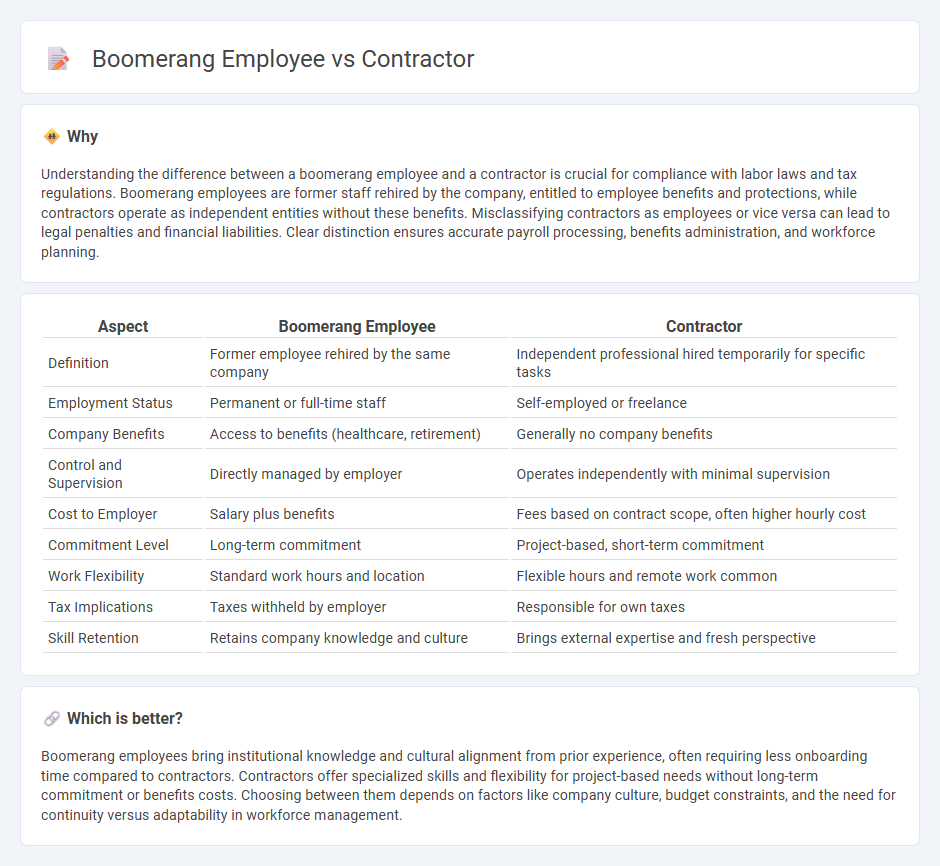
Boomerang employees return to a company after leaving, bringing enhanced skills and company knowledge that boost productivity and reduce onboarding time. Contractors offer specialized expertise on a temporary or project basis, providing flexibility and cost savings without long-term commitments. Discover how choosing between boomerang employees and contractors can optimize your workforce strategy.
Why it is important
Understanding the difference between a boomerang employee and a contractor is crucial for compliance with labor laws and tax regulations. Boomerang employees are former staff rehired by the company, entitled to employee benefits and protections, while contractors operate as independent entities without these benefits. Misclassifying contractors as employees or vice versa can lead to legal penalties and financial liabilities. Clear distinction ensures accurate payroll processing, benefits administration, and workforce planning.
Comparison Table
| Aspect | Boomerang Employee | Contractor |
|---|---|---|
| Definition | Former employee rehired by the same company | Independent professional hired temporarily for specific tasks |
| Employment Status | Permanent or full-time staff | Self-employed or freelance |
| Company Benefits | Access to benefits (healthcare, retirement) | Generally no company benefits |
| Control and Supervision | Directly managed by employer | Operates independently with minimal supervision |
| Cost to Employer | Salary plus benefits | Fees based on contract scope, often higher hourly cost |
| Commitment Level | Long-term commitment | Project-based, short-term commitment |
| Work Flexibility | Standard work hours and location | Flexible hours and remote work common |
| Tax Implications | Taxes withheld by employer | Responsible for own taxes |
| Skill Retention | Retains company knowledge and culture | Brings external expertise and fresh perspective |
Which is better?
Boomerang employees bring institutional knowledge and cultural alignment from prior experience, often requiring less onboarding time compared to contractors. Contractors offer specialized skills and flexibility for project-based needs without long-term commitment or benefits costs. Choosing between them depends on factors like company culture, budget constraints, and the need for continuity versus adaptability in workforce management.
Connection
Boomerang employees and contractors share a dynamic role in workforce flexibility, often rejoining organizations with enhanced skills and institutional knowledge that benefit project continuity and innovation. Companies leverage boomerang employees returning from contractor roles or vice versa to optimize talent management, reduce onboarding costs, and maintain a strong organizational culture. This strategic rehiring practice bridges the gap between permanent employment and flexible contract work, aligning with evolving business needs and labor market trends.
Key Terms
Independent Contractor
Independent contractors operate as self-employed professionals, providing specialized services without the long-term commitment of traditional employment. They maintain control over their work methods, schedules, and client relationships, distinguishing them from boomerang employees who return to former employers as full-time staff. Explore comprehensive insights to understand the benefits and challenges of engaging independent contractors.
Rehire
Contractors operate on fixed-term agreements without long-term employment expectations, while boomerang employees are former staff members who return to their previous organization, bringing familiarity and reduced onboarding time. Boomerang employees often offer strategic rehire benefits such as cultural fit and retained institutional knowledge, whereas contractors provide flexible skills-based engagement without rehire obligations. Explore how businesses strategically manage contractor contracts and boomerang employee rehiring to optimize workforce efficiency and talent retention.
Employment Status
Contractors operate as independent entities typically engaged under fixed-term agreements, lacking traditional employee benefits and consistent job security, distinguishing their employment status from regular staff. Boomerang employees, however, are former full-time employees who rejoin the organization with reinstated benefits, job roles, and employment protections, often contributing enhanced value due to prior company experience. Explore the differences between these employment statuses to optimize workforce strategy and legal compliance.
Source and External Links
General Contractor - A general contractor oversees construction projects, managing vendors, trades, and communicating with all parties involved.
What Are Contractors and What Do They Do? - This article explains the roles of different types of contractors, including general contractors and subcontractors, in construction projects.
Contractor - A contractor is a person or company that performs work on a contract basis, encompassing various roles in different industries.
 dowidth.com
dowidth.com